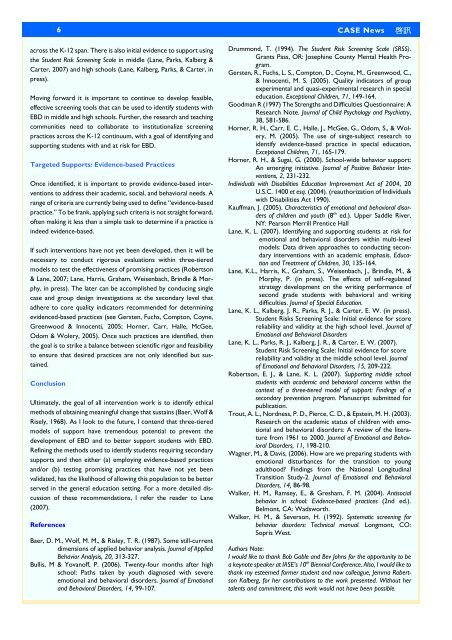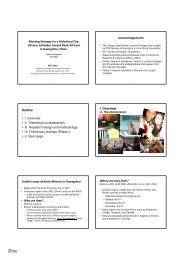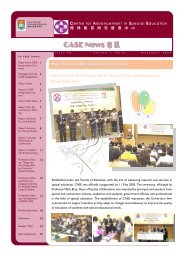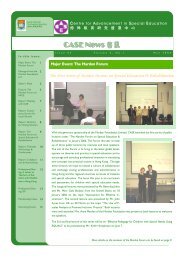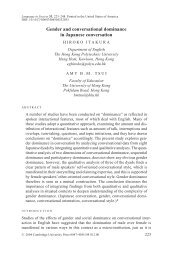Issue No.5 - Faculty of Education - The University of Hong Kong
Issue No.5 - Faculty of Education - The University of Hong Kong
Issue No.5 - Faculty of Education - The University of Hong Kong
Create successful ePaper yourself
Turn your PDF publications into a flip-book with our unique Google optimized e-Paper software.
6<br />
across the K-12 span. <strong>The</strong>re is also initial evidence to support using<br />
the Student Risk Screening Scale in middle (Lane, Parks, Kalberg &<br />
Carter, 2007) and high schools (Lane, Kalberg, Parks, & Carter, in<br />
press).<br />
Moving forward it is important to continue to develop feasible,<br />
effective screening tools that can be used to identify students with<br />
EBD in middle and high schools. Further, the research and teaching<br />
communities need to collaborate to institutionalize screening<br />
practices across the K-12 continuum, with a goal <strong>of</strong> identifying and<br />
supporting students with and at risk for EBD.<br />
Targeted Supports: Evidence-based Practices<br />
Once identified, it is important to provide evidence-based interventions<br />
to address their academic, social, and behavioral needs. A<br />
range <strong>of</strong> criteria are currently being used to define “evidence-based<br />
practice.” To be frank, applying such criteria is not straight forward,<br />
<strong>of</strong>ten making it less than a simple task to determine if a practice is<br />
indeed evidence-based.<br />
If such interventions have not yet been developed, then it will be<br />
necessary to conduct rigorous evaluations within three-tiered<br />
models to test the effectiveness <strong>of</strong> promising practices (Robertson<br />
& Lane, 2007; Lane, Harris, Graham, Weisenbach, Brindle & Morphy,<br />
in press). <strong>The</strong> later can be accomplished by conducing single<br />
case and group design investigations at the secondary level that<br />
adhere to core quality indicators recommended for determining<br />
evidenced-based practices (see Gersten, Fuchs, Compton, Coyne,<br />
Greenwood & Innocenti, 2005; Horner, Carr, Halle, McGee,<br />
Odom & Wolery, 2005). Once such practices are identified, then<br />
the goal is to strike a balance between scientific rigor and feasibility<br />
to ensure that desired practices are not only identified but sustained.<br />
Conclusion<br />
Ultimately, the goal <strong>of</strong> all intervention work is to identify ethical<br />
methods <strong>of</strong> obtaining meaningful change that sustains (Baer, Wolf &<br />
Risely, 1968). As I look to the future, I contend that three-tiered<br />
models <strong>of</strong> support have tremendous potential to prevent the<br />
development <strong>of</strong> EBD and to better support students with EBD.<br />
Refining the methods used to identify students requiring secondary<br />
supports and then either (a) employing evidence-based practices<br />
and/or (b) testing promising practices that have not yet been<br />
validated, has the likelihood <strong>of</strong> allowing this population to be better<br />
served in the general education setting. For a more detailed discussion<br />
<strong>of</strong> these recommendations, I refer the reader to Lane<br />
(2007).<br />
References<br />
Baer, D. M., Wolf, M. M., & Risley, T. R. (1987). Some still-current<br />
dimensions <strong>of</strong> applied behavior analysis. Journal <strong>of</strong> Applied<br />
Behavior Analysis, 20, 313-327.<br />
Bullis, M & Yovan<strong>of</strong>f, P. (2006). Twenty-four months after high<br />
school: Paths taken by youth diagnosed with severe<br />
emotional and behavioral disorders. Journal <strong>of</strong> Emotional<br />
and Behavioral Disorders, 14, 99-107.<br />
CASE News 啟訊<br />
Drummond, T. (1994). <strong>The</strong> Student Risk Screening Scale (SRSS).<br />
Grants Pass, OR: Josephine County Mental Health Program.<br />
Gersten, R., Fuchs, L. S., Compton, D., Coyne, M., Greenwood, C.,<br />
& Innocenti, M. S. (2005). Quality indicators <strong>of</strong> group<br />
experimental and quasi-experimental research in special<br />
education. Exceptional Children, 71, 149-164.<br />
Goodman R (1997) <strong>The</strong> Strengths and Difficulties Questionnaire: A<br />
Research Note. Journal <strong>of</strong> Child Psychology and Psychiatry,<br />
38, 581-586.<br />
Horner, R. H., Carr, E. C., Halle, J., McGee, G., Odom, S., & Wolery,<br />
M. (2005). <strong>The</strong> use <strong>of</strong> singe-subject research to<br />
identify evidence-based practice in special education,<br />
Exceptional Children, 71, 165-179.<br />
Horner, R. H., & Sugai, G. (2000). School-wide behavior support:<br />
An emerging initiative. Journal <strong>of</strong> Positive Behavior Interventions,<br />
2, 231-232.<br />
Individuals with Disabilities <strong>Education</strong> Improvement Act <strong>of</strong> 2004, 20<br />
U.S.C. 1400 et esq. (2004). (reauthorization <strong>of</strong> Individuals<br />
with Disabilities Act 1990).<br />
Kauffman, J. (2005). Characteristics <strong>of</strong> emotional and behavioral disorders<br />
<strong>of</strong> children and youth (8 th ed.). Upper Saddle River,<br />
NY: Pearson Merrill Prentice Hall<br />
Lane, K. L. (2007). Identifying and supporting students at risk for<br />
emotional and behavioral disorders within multi-level<br />
models: Data driven approaches to conducting secondary<br />
interventions with an academic emphasis. <strong>Education</strong><br />
and Treatment <strong>of</strong> Children, 30, 135-164.<br />
Lane, K.L., Harris, K., Graham, S., Weisenbach, J., Brindle, M., &<br />
Morphy, P. (in press). <strong>The</strong> effects <strong>of</strong> self-regulated<br />
strategy development on the writing performance <strong>of</strong><br />
second grade students with behavioral and writing<br />
difficulties. Journal <strong>of</strong> Special <strong>Education</strong>.<br />
Lane, K. L., Kalberg, J. R., Parks, R. J., & Carter, E. W. (in press).<br />
Student Risks Screening Scale: Initial evidence for score<br />
reliability and validity at the high school level. Journal <strong>of</strong><br />
Emotional and Behavioral Disorders<br />
Lane, K. L., Parks, R. J., Kalberg, J. R., & Carter, E. W. (2007).<br />
Student Risk Screening Scale: Initial evidence for score<br />
reliability and validity at the middle school level. Journal<br />
<strong>of</strong> Emotional and Behavioral Disorders, 15, 209-222.<br />
Robertson, E. J., & Lane, K. L. (2007). Supporting middle school<br />
students with academic and behavioral concerns within the<br />
context <strong>of</strong> a three-tiered model <strong>of</strong> support: Findings <strong>of</strong> a<br />
secondary prevention program. Manuscript submitted for<br />
publication.<br />
Trout, A. L., Nordness, P. D., Pierce, C. D., & Epstein, M. H. (2003).<br />
Research on the academic status <strong>of</strong> children with emotional<br />
and behavioral disorders: A review <strong>of</strong> the literature<br />
from 1961 to 2000. Journal <strong>of</strong> Emotional and Behavioral<br />
Disorders, 11, 198-210.<br />
Wagner, M., & Davis, (2006). How are we preparing students with<br />
emotional disturbances for the transition to young<br />
adulthood? Findings from the National Longitudinal<br />
Transition Study-2. Journal <strong>of</strong> Emotional and Behavioral<br />
Disorders, 14, 86-98.<br />
Walker, H. M., Ramsey, E., & Gresham, F. M. (2004). Antisocial<br />
behavior in school: Evidence-based practices (2nd ed.).<br />
Belmont, CA: Wadsworth.<br />
Walker, H. M., & Severson, H. (1992). Systematic screening for<br />
behavior disorders: Technical manual. Longmont, CO:<br />
Sopris West.<br />
Authors Note:<br />
I would like to thank Bob Gable and Bev Johns for the opportunity to be<br />
a keynote speaker at IASE’s 10 th Biennial Conference. Also, I would like to<br />
thank my esteemed former student and now colleague, Jemma Robertson<br />
Kalberg, for her contributions to the work presented. Without her<br />
talents and commitment, this work would not have been possible.


